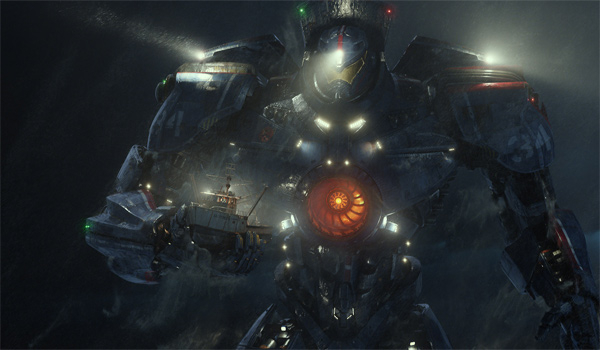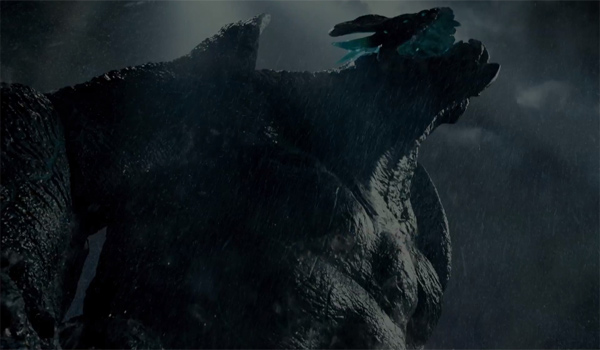Kaiju films are kind of a niche genre. While everybody has a passing acknowledgment of Godzilla films and the like, they’re not as immediately accepted in mainstream culture. Sure, there are cult followings and small subcultures that embrace and adore the inherent geekiness of watching a man dressed in a latex monster suit trample across a model town, but they’re not as easily accepted as, say… superhero films. Attempts have been made over the years, with two of my recent favorites being Cloverfield and Super 8, but they just haven’t clicked.
My theory is there’s a missing element, a level of wonderment that’s lost amongst the scenes of total destruction and chaos. Super 8 attempted to capture that innocence and entertainment, but was muddied by government wrangling and politicking (as well as trying a tad too hard in creating a pastiche of past Steven Spielberg films). Pacific Rim is director Guillermo del Toro’s (Pan’s Labyrinth) largest film to date, both in budget and ambition; can he do with monster movies what X-Men did with the superhero genre?
Pacific Rim
Director: Guillermo del Toro
Rating: PG-13
Release Date: July 12, 2013
Kaiju, Japanese for “giant monster,” have arisen from the Pacific Rim wreaking havoc across the world, resulting in a united world war against the common threat. Initial attacks proved fruitless, leading to the human forces to create large robots named “Jaegers.” However, they proved to be too unstable for one person to control, so multiple-manned machines were created. Each pilot is subjected to linking their minds with one another in a process called “drifting,” allowing them to work seamlessly not only with one another, but with the machine as well.
While the Jaegers were enough to fight off the Kaiju, they continued to come back with adapted strategies. With government support dwindling and the Kaiju attacks rising, one final push is made by Marshal Stacker Pentecost (Idris Elba) who employs the help from an ex-Jaeger pilot, Raleigh Becket (Charlie Hunnam), who himself has been struggling with survivor’s guilt for the previous five years. With the aid of a rookie Jaeger pilot, Mako Mori (Rinko Kikuchi), it’s up to Raleigh and a small number of Jaeger pilots to help save the world from the Kaiju threat.
One of the most obvious things I noticed about Pacific Rim is the color palette. For a movie that’s somewhat surrounded by dread and despair, it’s brightly-colored and not muddled with a hazy, grayscale hue. Furthermore, the film isn’t bogged down by the aforementioned politicking that takes away from the sheer entertainment of watching giant robots fight monsters. Sure, there’s a military setting, but there isn’t a large military focus in the same way Transformers, for example, overshadowed the actual Transformers themselves.
Furthermore, Pacific Rim is kept thematically light. I was hoping for something a bit deeper in terms of themes or something to analyze deeply, but after the film ended, I realized that it wasn’t really needed. There’s some mind fodder with the notion of having to connect with another person’s emotions, attitude, memories, etc. as part of the drifting process, which could make for a little essay, but nothing too substantial. If you’re also looking for a deeper motive for the Kaiju’s attacks, you won’t find it. And honestly, I like it better this way. del Toro kept the focus on the pilots and Jaegers, and any extra exposition would have thrown off the film’s balance. There’s still a good plot attached to the film with slight anecdotes/arcs characterizing even the most minor of background characters, as well as a fun subplot revolving around a kaiju-obsessed doctor (Charlie Day) attempting to attain a live kaiju brain from a black market dealer (Ron Perlman).
The lack of heavy-handedness allows the audience to truly cherish the entertainment value of the film. Through every fight scene, I kept thinking about how much fan service del Toro put into them. As I’ve publicly stated in a multitude of outlets: the robots use boats as swords. If that doesn’t trigger a happy reaction in your subconscious, you truly don’t know fun. The thing is, del Toro can and has created films that are heavy with the allegory; he simply felt that it didn’t fit in with the tone he wanted to accomplish with Pacific Rim. For that, I truly thank him for understanding the inherent entertainment of watching robots fighting monsters.
Pacific Rim was intended by del Toro to be an introduction to the kaiju and robot genres for children and newcomers. In saying that, it definitely has a broader appeal than most other kaiju/robot films; however, it does leave a bit more for those of us who are already familiar with the genre. It’s a mixed bag, as I certainly demonstrated earlier. Why I have enjoyed a more psychological/philosophical/existential theme? Of course. Does it fit with del Toro’s vision for the film? Of course not.
What Pacific Rim comes down to is whether or not you’ll enjoy yourself watching it. Believe me when I say you will. The fight scenes are remarkable and entertaining; there’s no other simple joy than watching two large entities fighting one another. del Toro is the type of visionary Hollywood needs right now; he understands what the audience wants and deserves, and does his best to serve them in a way that also fits his vision. Pacific Rim is sheer proof of the type of film he not only enjoys, but feels that the movie audiences would, as well. After all, there are robots using boats as swords. Come on.
Score: 7.5 out of 10


